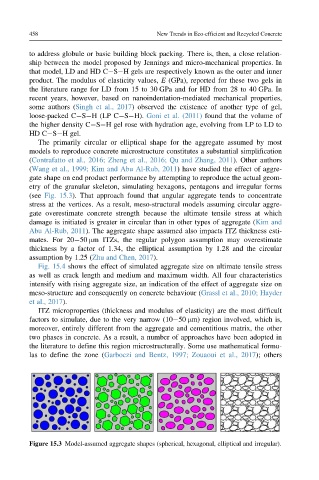Page 508 - New Trends in Eco efficient and Recycled Concrete
P. 508
458 New Trends in Eco-efficient and Recycled Concrete
to address globule or basic building block packing. There is, then, a close relation-
ship between the model proposed by Jennings and micro-mechanical properties. In
that model, LD and HD C S H gels are respectively known as the outer and inner
product. The modulus of elasticity values, E (GPa), reported for these two gels in
the literature range for LD from 15 to 30 GPa and for HD from 28 to 40 GPa. In
recent years, however, based on nanoindentation-mediated mechanical properties,
some authors (Singh et al., 2017) observed the existence of another type of gel,
loose-packed C S H (LP C S H). Goni et al. (2011) found that the volume of
the higher density C S H gel rose with hydration age, evolving from LP to LD to
HD C S H gel.
The primarily circular or elliptical shape for the aggregate assumed by most
models to reproduce concrete microstructure constitutes a substantial simplification
(Contrafatto et al., 2016; Zheng et al., 2016; Qu and Zhang, 2011). Other authors
(Wang et al., 1999; Kim and Abu Al-Rub, 2011) have studied the effect of aggre-
gate shape on end product performance by attempting to reproduce the actual geom-
etry of the granular skeleton, simulating hexagons, pentagons and irregular forms
(see Fig. 15.3). That approach found that angular aggregate tends to concentrate
stress at the vertices. As a result, meso-structural models assuming circular aggre-
gate overestimate concrete strength because the ultimate tensile stress at which
damage is initiated is greater in circular than in other types of aggregate (Kim and
Abu Al-Rub, 2011). The aggregate shape assumed also impacts ITZ thickness esti-
mates. For 20 50 μm ITZs, the regular polygon assumption may overestimate
thickness by a factor of 1.34, the elliptical assumption by 1.28 and the circular
assumption by 1.25 (Zhu and Chen, 2017).
Fig. 15.4 shows the effect of simulated aggregate size on ultimate tensile stress
as well as crack length and medium and maximum width. All four characteristics
intensify with rising aggregate size, an indication of the effect of aggregate size on
meso-structure and consequently on concrete behaviour (Grassl et al., 2010; Hayder
et al., 2017).
ITZ microproperties (thickness and modulus of elasticity) are the most difficult
factors to simulate, due to the very narrow (10 50 μm) region involved, which is,
moreover, entirely different from the aggregate and cementitious matrix, the other
two phases in concrete. As a result, a number of approaches have been adopted in
the literature to define this region microstructurally. Some use mathematical formu-
las to define the zone (Garboczi and Bentz, 1997; Zouaoui et al., 2017); others
Figure 15.3 Model-assumed aggregate shapes (spherical, hexagonal, elliptical and irregular).

